The Drukair Airbus A319 which took us from Singapore began making its descent, but seated by the aisle meant the Bhutanese sky and clouds were the only things I could see from the windows on both sides of the plane. As James was kept busy chatting with a talkative Aussie who was sitting by the window, the plane started making a series of maneuvers, tilting to the left and right and left again, though I didn’t really count as each turn afforded me glimpses of Bhutan’s hills which in some countries would be considered mountains. At some points the hilltops seemed to be too close, and unnervingly so – unsurprisingly just a handful of pilots are qualified to fly in and out of this mountainous country. After several minutes the plane made a final turn to the right and soon I could hear the wheels touching the runway. We’re here, we’ve arrived in Bhutan!
After Nepal in 2015, Bhutan is the second country in the Himalayas that I’ve had the chance to visit, although my fascination for this part of the world began way back more than twenty years ago when I first saw a photo of Tibet’s Potala Palace in one of my father’s old books. However, unlike Tibet which is now part of China and Sikkim which was absorbed into India, Bhutan and Nepal remain independent up to this day, making them the only ancient countries in the Himalayas that have not become part of their much larger neighbors to the north and south.
As we walked past the flight attendants who were wearing green tego (a long sleeve, jacket-like garment) and matching kira (an ankle-length woven fabric with traditional motifs), the fresh crisp air of Bhutan rushed into my lungs, which unfortunately are too accustomed to Jakarta’s polluted air.
“I can smell fresh pine,” James recalled a scent that he remembered from his past trips to Canada.
We walked down the stairs onto the tarmac, and those disembarking before us were already taking photos of the plane, the airport and the dramatic landscape surrounding it. We were at Paro International Airport, the sole international airport in the entire country, situated in the namesake town an hour’s drive away from the capital, Thimphu. We entered the small arrival hall through doors and passageways ornately decorated with Bhutanese architectural elements, and before long we were greeted by Kinga, our guide throughout our seven-day maiden trip to Bhutan. His imposing stature made him stand out among other guides, and as soon as we got to our white minivan with Phuntsho at the steering wheel, Kinga handed out two long white shawls, a cultural tradition which is similar with what we experienced in Nepal. In the latter, however, the shawl is usually given upon departure as a token of good wishes.
On our way to Thimphu, Kinga explained to us facts about his native land as he handed me a large envelope filled with a booklet on Bhutan, a brochure from the government containing the country’s statistical data, our itinerary, and a postcard of Tiger’s Nest – probably Bhutan’s most iconic site – shot on a cloudy day. Little did we know that this was a sign of how the weather would be when we hiked to the cliffside monastery five days later, as opposed to the clear sky above us with only a few patches of cloud.
The road snaked around verdant as well as barren hills. On the right side I saw layers of exposed rocks and couldn’t help but wonder if millions of years ago those were also part of the seabed which slowly collided with the Eurasian Plate and created the mighty Himalayas. This was a reminder for me of how unique this country is; for years many things about Bhutan have been intriguing me, from its pursuit of happiness – an unconventional way in measuring its progress as a nation – to the fact that it is the only country in the world that is carbon negative, which means it absorbs more carbon dioxide in the air than it releases. Many who had gone to Bhutan before me recounted their own incredible experiences in the country, but I always tend to take things with a grain of salt, hence the lingering question in my head: is Bhutan really a perfect place?
Last year I came across an article exposing a side of Bhutan often overlooked by most people. Beyond the Gross National Happiness that has defined the world’s perception of Bhutan, one journalist reported the country’s growing problem with drugs, prevalent particularly among its young population. Then on their latest annual World Happiness Report, the United Nations placed Bhutan in the 97th position, a conspicuously stark contrast to the Himalayan kingdom’s reputation as a place that emphasizes happiness above everything else. Could there be a misunderstanding among the global community of this small nation? That’s what I was so eager to find out on this trip.
“72% of Bhutan is covered with forests,” Kinga repeated a fact we learned from the country’s outgoing prime minister on a TED talk video we watched a few weeks prior to the trip. “But some of that is a result of reforestation,” he added. “Many of these hills were once barren, then the government started planting trees.”
We stopped by a small iron bridge which is no longer in use. As we walked down from the main road, a small river with crystal clear water was running before my eyes. It was so clean the pebbles at the bottom were visible – I can’t remember the last time I saw a river this clean in Indonesia. With a land area just a little smaller than Switzerland, the entire population of Bhutan is less than 10% of the European nation’s 8.5 million inhabitants (in comparison, Indonesia’s West Java province which is about the same size as Bhutan has more than 46 million people).
We soon learned that Kinga was in fact a fountain of knowledge when it came to Bhutanese culture and tradition. He explained the reasoning behind the colorful prayer flags which are evident across the Himalayas: each color represents one of the natural elements and they must be mounted at windy places to allow the wind to carry the prayers. Then there are prayer poles – typically 108 of them at each location – which are erected as a remembrance of those who have passed away. This aspect of Buddhism (about 75% of all Bhutanese are Buddhists) is similar to the form I witnessed in Nepal, yet so different from the one practiced in places like Thailand, Myanmar and Sri Lanka which follow a different school of Buddhism.
Back on the road to the capital, Kinga said to us that throughout the trip we would try Bhutanese food, “but we’ll take it easy, okay? For your first meal in Bhutan we will go to a Western restaurant to have lunch.”
“Let’s start with Bhutanese food, we love trying local dishes,” James convinced Kinga with me nodding in agreement.
“Are you sure?” Kinga seemed a little concerned.
“Yes, we’re sure.”
We knew how Bhutanese food would be like – a lot of cheese and chilies – and it was in fact one of the things we were looking forward to trying the most in this trip. Discussing with Phuntsho in Dzongkha, Bhutan’s national language which to me sounded a little similar with Burmese (both belong to the Tibeto-Burman language group), they seemed to agree on an alternative place to take us for lunch. As we were entering Thimphu, the nation’s capital which sits more than 2,300 meters above sea level, Phuntsho pulled the car over at a modest restaurant.
We went inside what seemed to be a family-run venue and were seated inside a small room with four tables and long chairs. Kinga gave us the menu and one dish immediately caught our attention: ema datshi. I learned about this Bhutanese dish two years ago and was instantly intrigued. Chilies with cheese? I had never heard of such an interesting combination before. We entrusted Kinga with choosing the rest, and he ended up ordering a little too much food the four of us could handle. Shakam paa (dried beef cooked with dried chilies and radish), shamu datshi (cheese with mushrooms), shakam shukam datshi (dried beef, white chilies and cheese), jaju (a dairy-and-vegetable soup made with local spinach), and of course ema datshi. For drinks we had suja, Bhutanese butter tea with a dash of salt. Overall our lunch was a great introduction to Bhutanese food which is little known beyond the kingdom’s borders.
With full stomachs, Kinga took us to the local farmer’s market since it was Sunday, the last day of the week before the market was emptied again until the following Friday. We walked past stalls selling chilies – fresh and dried – with some varieties I’ve never seen in Indonesia, fresh fruits, spices, cereals, and dried fish (Bhutan is a landlocked country and most fish is imported from India). “Apart from some fruits and vegetables, we import a lot of things from India,” Kinga explained. As a matter of fact, Bhutan exports 70% of the electricity it produces from its hydroelectric power plants to its giant neighbor to the south, but it imports fuel in return. This seemingly precarious economic relationship between Bhutan and India resonates with what the small country’s outgoing prime minister said in his TED talk. “We are a small underdeveloped country doing our best to survive.”
What’s heartening was when Kinga told us that instead of building dams which have proven to cause great environmental damage in many places around the world, Bhutan relies on diversion tunnels to generate electricity so natural habitats downstream won’t be affected.
The last place we visited before checking in at our hotel was Tashichho Dzong, a large religious and secular compound which has been used as the seat of Bhutan’s government since 1968, a few years after the capital of the kingdom was moved from Punakha to Thimphu. Housing the throne room, the cabinet secretariat, and the offices of some ministries, the fortress is a reconstruction of a previous structure which was damaged by fire. Like all buildings in Bhutan, the imposing complex was built in accordance with Bhutanese traditional architectural elements as regulated in the Driglam Namzha, a set of rules which dictates not only how buildings in Bhutan should be constructed, but also how men and women should dress in public – therefore the ubiquity of men wearing gho and women draped in kira.
As the sun began to set behind the mountains to the west, we finally went to our hotel which was located in the outskirts of Thimphu. As we entered the small hotel’s lobby, Auntie Ugyen who runs the place with her husband welcomed us with a heartfelt hospitality that reminded me of the warm welcome I received in Nepal. One of her staff members was a friendly young woman who gave us hot ginger and honey tea which was perfect as the temperatures in the capital were beginning to drop. After chatting with us a little bit, Auntie Ugyen showed us our spacious and homey room which later that night James told me reminded him of Canada. Dinner was great – we had some of the best food in Bhutan there – and around 10pm off we went for some much-needed sleep after waking up at 3 in the morning to catch our flight from Singapore to Paro. So far Bhutan had been so good to us, and I knew another interesting day with Kinga and Phuntsho awaited.
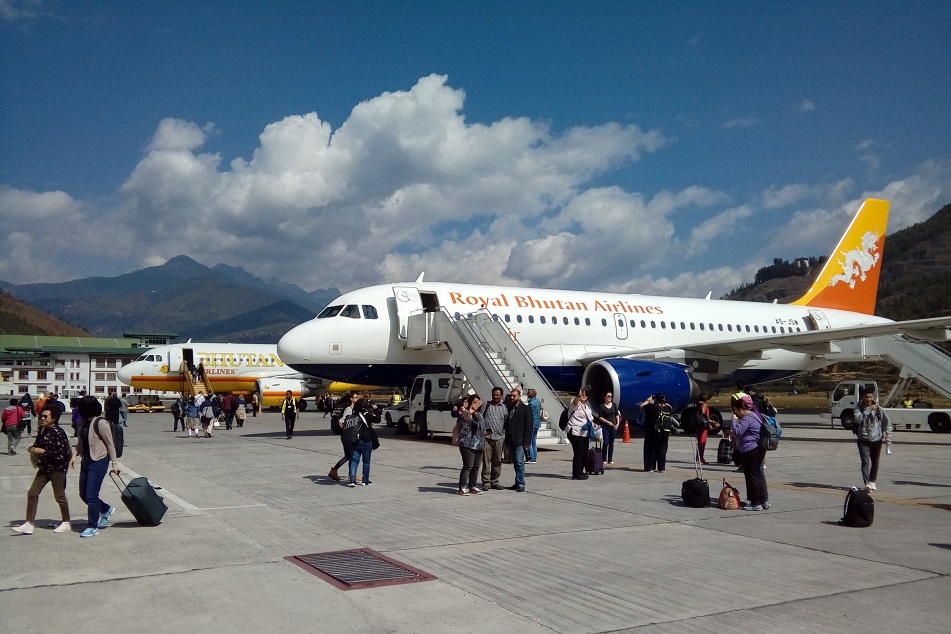
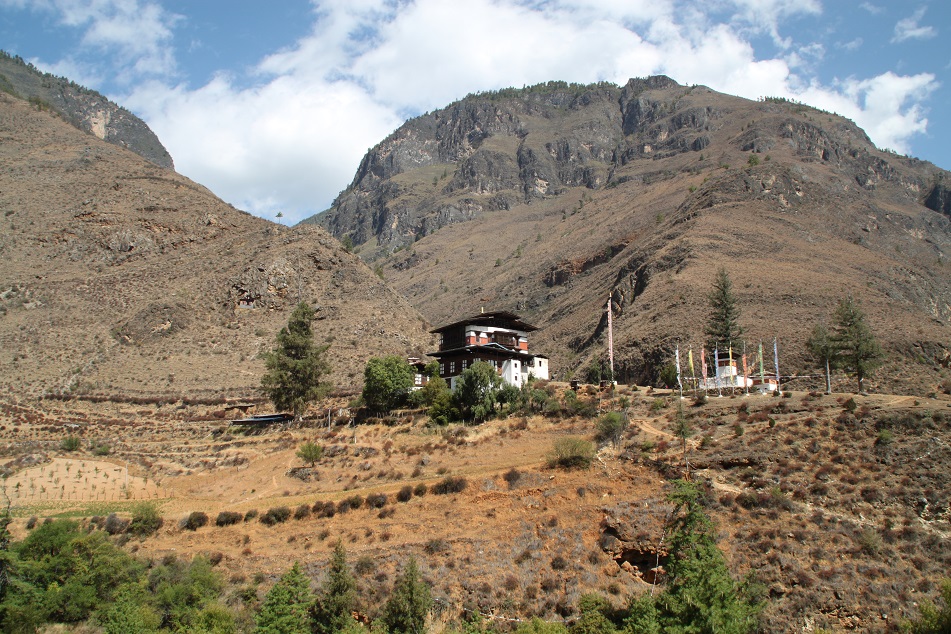

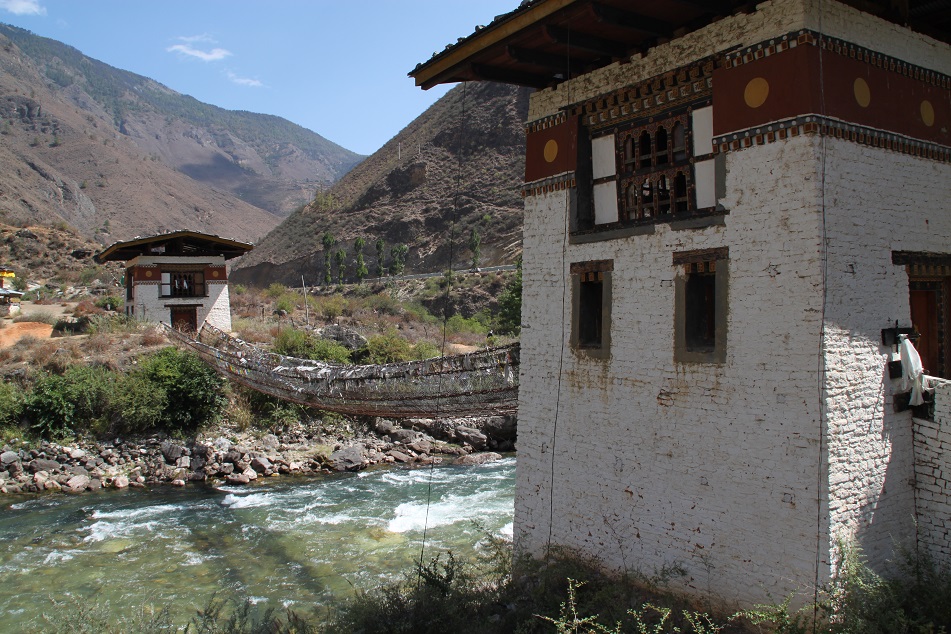
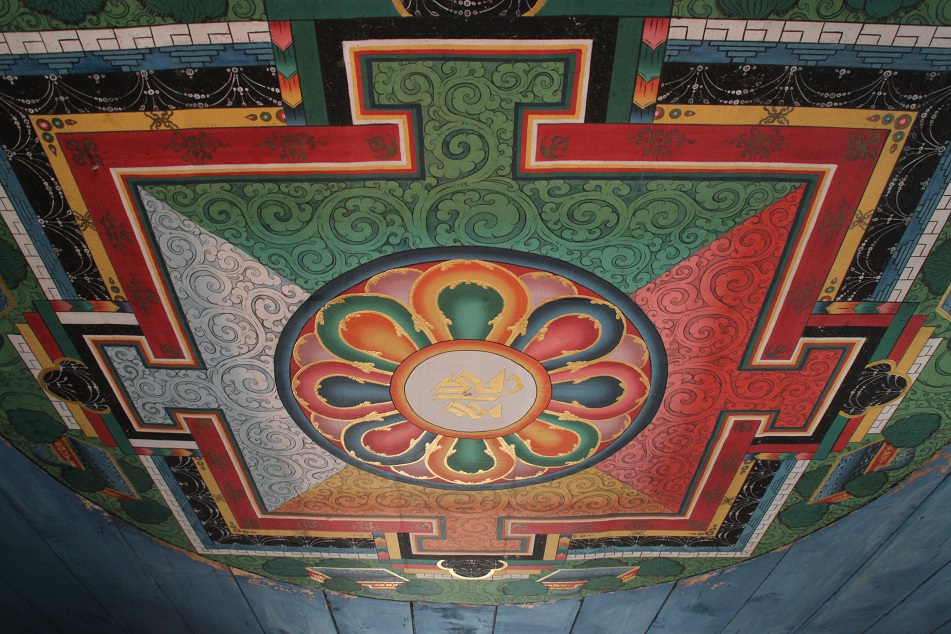
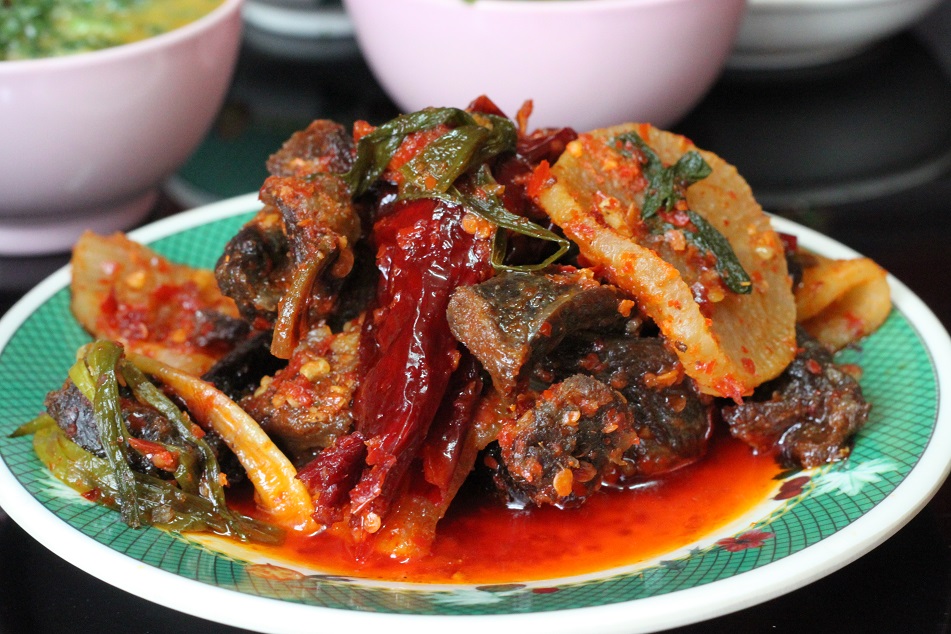

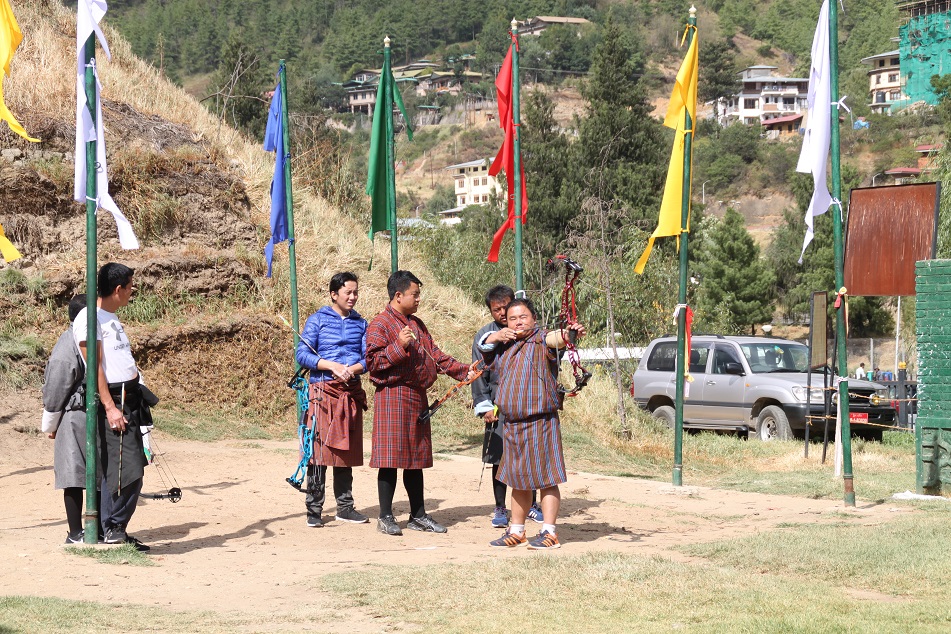

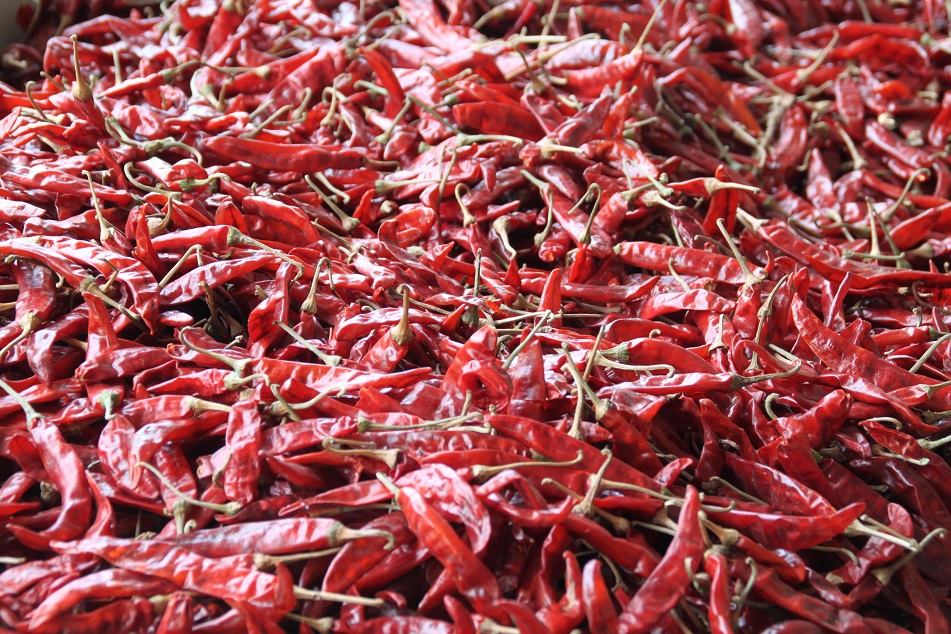
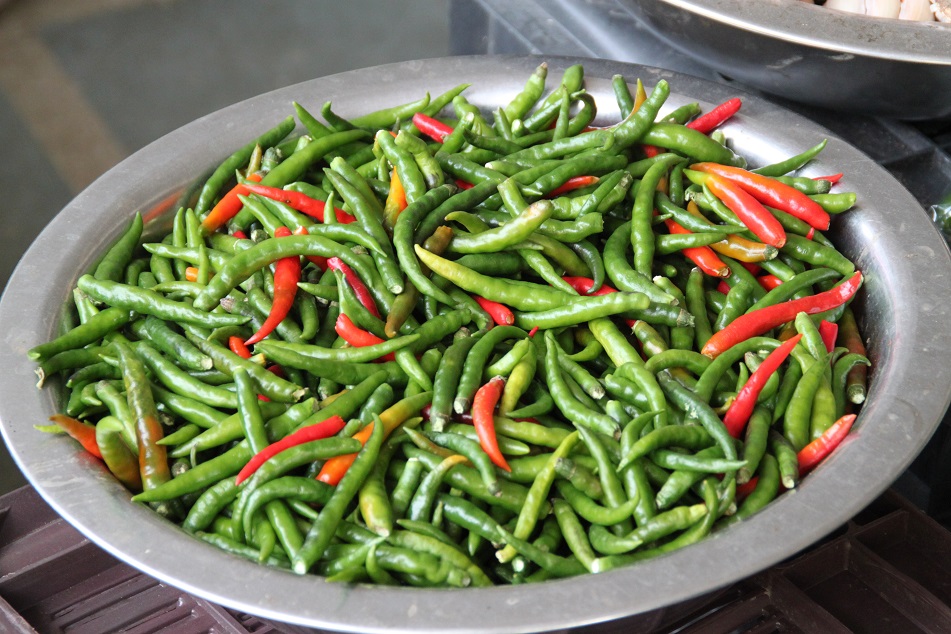
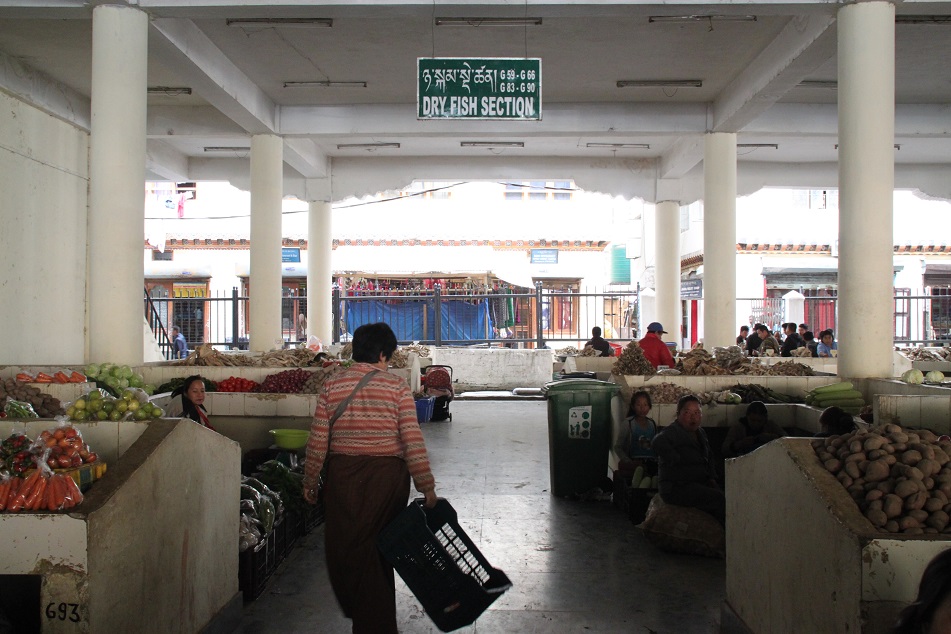
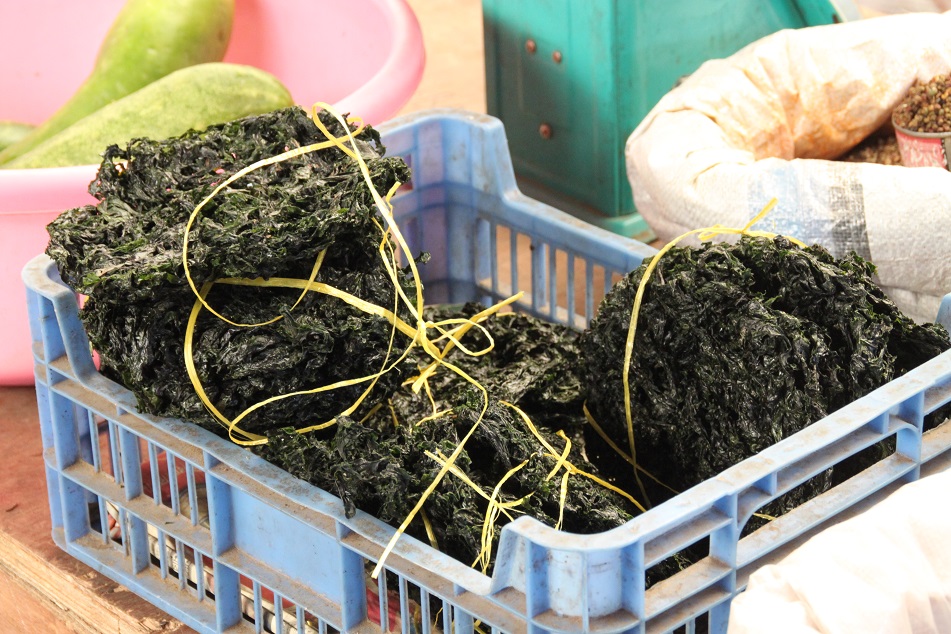
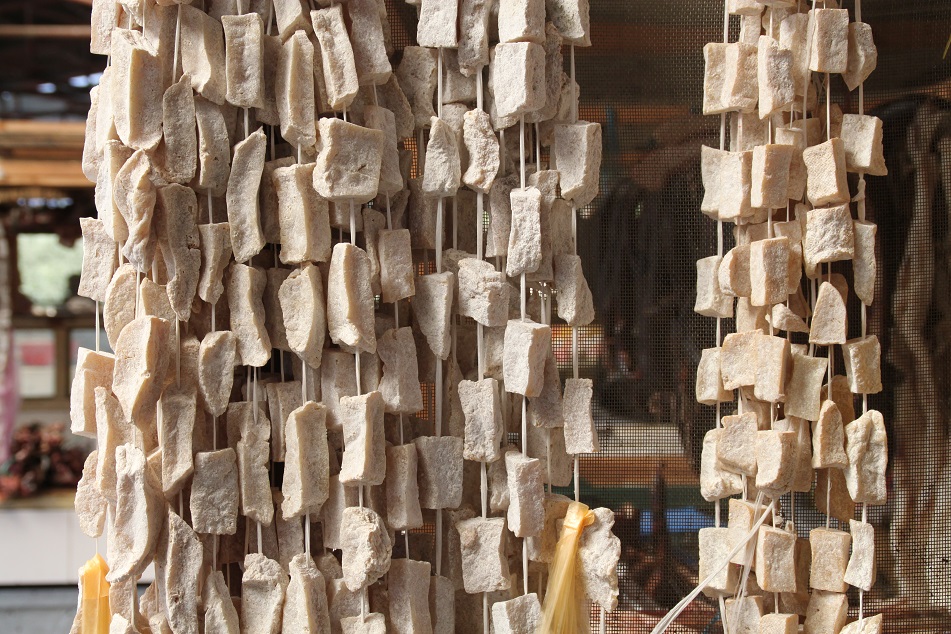


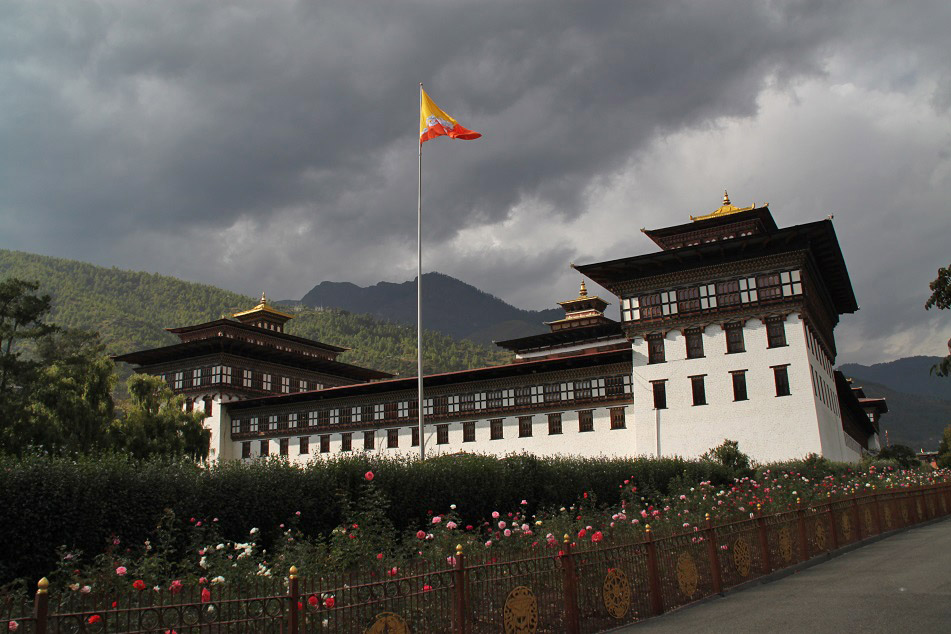

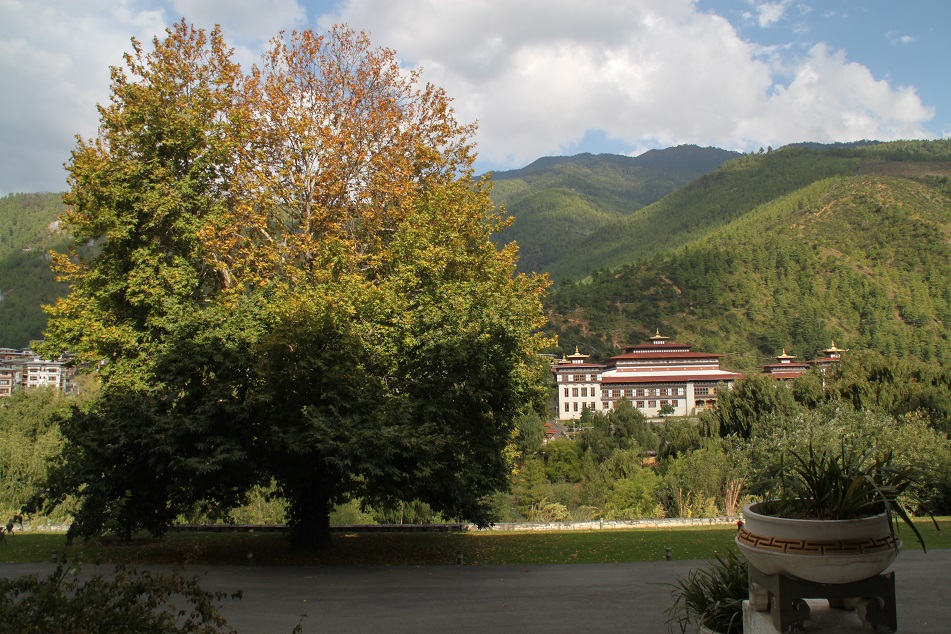

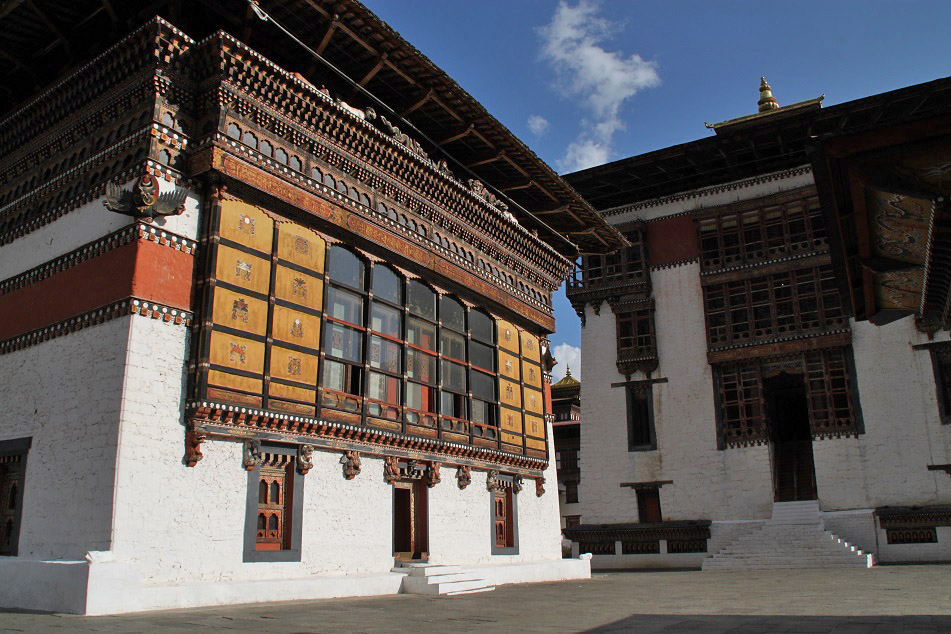

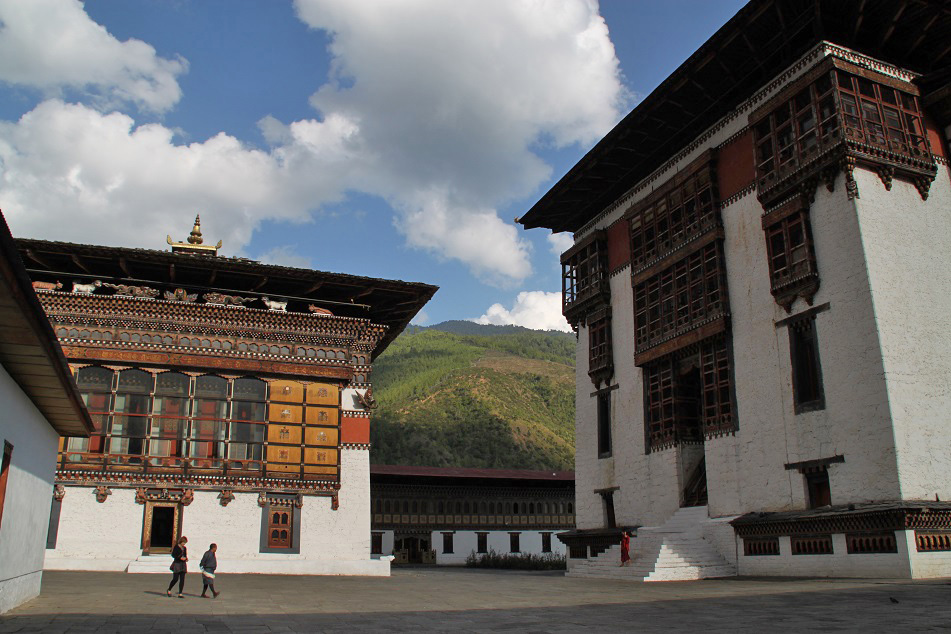
It’s heartening to hear of a society choosing environmentally responsible ways to meet its energy needs — even if it means that Bhutan is dependent on its larger neighbor for fuel. There are always trade-offs, I guess. It’s also fascinating to see from your photos of the food and clothes that the Bhutanese have a very strong cultural identity. I wonder if this sense of “belonging” is one of the things that contributes to their happiness? Or whether that label of happiness is perhaps too shallow? I’ll be eager to hear more of yours and James’ impressions of this beautiful country!
LikeLiked by 2 people
In general I feel that South Asians embrace their cultural identity even more dearly than most of their Southeast Asian counterparts, and this is particularly evident in what people wear every day — my travels to India, Sri Lanka, Nepal and recently Bhutan made me wonder how nice it would have been to see Indonesians proudly wearing their traditional dress to work and school. And yes you guessed it right; cultural preservation is one of the key elements to Bhutan’s Gross National Happiness which was conceived by the fourth king (as I’m replying to your comment, at the same time I’m also writing my next post explaining more about this). Thanks for reading, Heide.
LikeLiked by 2 people
“Chilies with cheese? I had never heard of such an interesting combination before.”
There’s a Mexican dish “chile relleno”, a green pepper stuffed with cheese, deep fried and smothered in tomato sauce. Very satisfying. Probably not as spicy as the Bhutanese dish though.
LikeLiked by 1 person
Wow, chile relleno sounds good! That’s a dish James and I will look forward to having when we go to Mexico one day — himself always a big lover of cheese while I myself can never say no to chili pepper.
LikeLike
Hi Bama, I truly enjoyed your post about Bhutan, it felt like reading a good book. If ever my travel budget would allow it, Bhutan would be the first to visit, You mentioned a few times some TED talks, would you have a reference to those, I would be so curious to listen to those. Have a splendid week.
LikeLike
Much appreciated, Cornelia. Bhutan is the place to go for those who love learning about other cultures, with the bonus of inspiring landscape and good food (at least for me since I love chilies). Here’s the link to that TED talk video: https://www.youtube.com/watch?v=7Lc_dlVrg5M&t=537s
Have a great week ahead!
LikeLike
Dear Bama, I thank you from the bottom of my heart for sending this link. I enjoyed listening and the humor of the prime minister. It made me even more wanting to visit Bhutan, as I am a professional photographer, focusing on spiritual photography. Thank you again and have a blessed week.
LikeLike
You’re very welcome, Cornelia. If spiritual photography is something you’re very passionate about, I think you would enjoy Bhutan.
LikeLiked by 1 person
Oh , definitely Bhutan would paradise for my eye and camera. I am actually working on a trip with my brother and his wife for next year maybe? Thank you so much for your kind response.
LikeLiked by 1 person
Try to get a window seat. You’ll get a nice view of the Himalayas. Your post makes me want to go back to Bhutan again 🙂
LikeLiked by 1 person
I did on the flight back to Singapore and I saw Mount Everest! It stood tall above everything else, even the clouds. Definitely one of the best views I’ve ever seen.
LikeLiked by 1 person
Awesome!
LikeLike
Waaaa udah nyampe Bhutan aja! I’m sooo jelly! Bhutan is one country I would love to explore along with Nepal. Both countries seems peaceful and laid back. I’m enjoying reading your story and beautiful pictures, Bama. Can’t wait for the next part (and more food photos!). That Shakam paa looks delish 😍
LikeLiked by 1 person
Jelly aku malah bayanginnya kenyal-kenyal empuk. 😀 I think you would love both countries, Deb, although I’m not sure which one works better for you: Bhutan first or Nepal first. More food photos are coming soon (plus photos of beautiful valleys, incredibly beautiful fortress, and other things I saw in Bhutan).
LikeLike
Beberapa yang kita obrolin soal makanannya langsung ada di sini nih. Keju dan rumput sungai (eh bener gak gini terjemahan bahasa Indonesia nya) langsung bikin aku penasaran 😀
LikeLiked by 1 person
Nah iya bener. Kali ini aku gak nulis satu postingan khusus tentang makanan, tapi akan aku tulis secara kronologis sesuai urutan perjalananku di Bhutan. Secara harafiah river weed artinya memang rumput sungai sih, tapi entahlah, mungkin ada nama yang lebih gak aneh di telinga orang Indonesia. 😀 By the way, jadi inget aku masih punya utang: share foto aku pake gho. 🙂
LikeLiked by 1 person
Stand by 86 Komandan!
Hahaha iya Bam, kutunggu foto pakai gho nya 🙂
LikeLike
Wah Bama! Bhutan looks amazing and serene. Really drawn to the dishes, are they chillies as spicy as the ones you’d find here in Indonesia? I’m looking forward to rest of your story, I’ve never really paid much attention to Bhutan but now you’ve really got me intrigued.
LikeLiked by 1 person
It was so refreshing to be in Bhutan, especially with far less people than what we’re used to seeing in Indonesia. The chilies were actually quite spicy, even for a person like me who loves his dishes with chili pepper. I still have five more posts on Bhutan, but I’ll take it easy. So sit back, relax, and get your popcorn ready, Aggy! 🙂
LikeLiked by 1 person
One of the times I visited Bhutan we took the bus up from the border. At every stop people would appear with steaming hot momos served with a wonderful chili paste. That, the chai, and the hard cheese which you suck on during long journeys are some of my early memories of Bhutanese food.
LikeLike
Oh the momos! I tried both veg and non-veg momos in Punakha, and actually the veg ones were better since they had more cheese inside. Too bad I didn’t try the hard cheese. Sounds like your past trip to Bhutan was quite an adventure!
LikeLike
Loved this post! It was super interesting to see their customs through your eyes! Bhutan is so fascinating to me, perhaps because it is so isolated/ not visited very often. I’d love to visit one day and taste the foods for myself and whatnot.
I think there is no accurate way to measure something as subjective as happiness. I had not read about Bhutan’s substance abuse issues. I have, however, read about illegal immigrants for cheap/ child labor being rampant in Bhutan. I think people are people. We all have problems whether we are rich or poor, young or old. Just because a country’s governing force attempts to measure a people’s happiness, does not mean people’s problems disappear. No matter what culture one lives, we are all just people/ living beings trying to make sense of our day-to-day lives.
LikeLiked by 1 person
Thanks! Happiness is indeed hard to quantify, let alone measure. What you said really makes sense; social problems exist even in the most prosperous places, and vice versa, living in an impoverished place doesn’t necessarily mean living constantly surrounded by danger. Thank you for sharing your thoughts, and hopefully you’ll go to Bhutan soon!
LikeLike
Bama, what an interesting post. Bhutan reminds me of Tibet, the architecture and the food are similar. I was very surprised to see chilies in their cuisine, how did chilies made their way there? I wonder what kind of chilies they prefer in Bhutan, I love trying all varieties of chilies. The pictures of the dishes look amazing!
LikeLiked by 1 person
I would love to see Tibet one day! In Drukair’s inflight magazine I read a story about how chilies arrived in Bhutan. So, in the 16th century they came to India, then two centuries later they made their way into Bhutan thanks to pilgrims and traders. Now, chilies are an inseparable part of Bhutanese cuisine.
LikeLiked by 1 person
Vividly described travel journal and clear photographs too! I like the reference to TED talks, authentic local food, and the mythical Garuda bird guarding over. The Ramayana describes the heroic act of this bird to save Sita from the clutches of Ravana.
LikeLiked by 1 person
Thanks Veena. Garuda is so revered in Indonesia it inspired the nation’s founding fathers to create a national emblem with a modified Garuda, then unsurprisingly country’s flag carrier is called Garuda Indonesia. In Thailand you can also see depictions of this mythical bird at their Buddhist temples.
LikeLike
You are seriously whetting my appetite for my April trip! I would have never associated a cheese-and-chilies dish with Bhutan – seems more like something on the menu here in Texas!
LikeLiked by 1 person
Yay! I’m glad this series on Bhutan makes you even more eager to go. And when you do, don’t forget to try ema datshi, at least once. 🙂 Although probably you would enjoy kewa datshi (potatoes and cheese) and mushroom datshi more.
LikeLiked by 1 person
Drug use problem? Is it a bloated-out-of-proportion dramatisation like too much weed being smoked by kids, or a proper issues like, I don’t know, heroin?
As much as I’d like to see Bhutan, I don’t know whether this emphasis on tradition must be stymying future progress. I suppose that traditions had to be new, once, and they must’ve replaced other traditions. Isn’t the way one develops?
LikeLiked by 1 person
I’ve been trying to find that article that I read, but unfortunately I can’t. It seems like the drug problem has not reached a worrying level, but enough for the government to roll out a PSA campaign focusing on the danger of drug abuse. Since there’s no commercial billboard in Bhutan so the message was evident in many places I went to.
As for the way they value their tradition, based on my observation it didn’t really hamper development in the country. For example, even though women are required to wear kira, but they have a women’s soccer team (who lost to neighboring Bangladesh on a match that was reported on a local English-language newspaper). Coming from Indonesia where a lot of people seem to have drifted away from their roots, I actually appreciate what Bhutan does to safeguard their rich culture.
LikeLiked by 1 person
Great post Bama. Interesting about the happiness level of the World Happiness Report. So sad to hear of the drug problem. I wonder how big of a problem it is. Bhutan looks fascinating, and I look forward to further stories of your visit.
Alison
LikeLike
Thanks Alison! GNH and the World Happiness Report use different sets of measurements, so no wonder Bhutan’s ranking is surprisingly low on the list. But it also helped me understand how we should perceive GNH, and through this series I will share my thoughts about it.
LikeLiked by 1 person
Thank you for this wonderful stroll down memory lane, Bama. Looking back now, I’m surprised at how much ground we covered that very first day as I was expecting to go straight from Paro airport to the hotel for check-in and a much-needed shower! As usual, the close-up pictures (especially when it comes to food and architecture) really stand out. I have to admit that your shots from the market were far better than mine – so many captures came out blurred, and I’m not sure if it was due to tiredness from lack of sleep and the early morning journey from Singapore!
LikeLiked by 1 person
The pleasure is mine, James. I’m glad even though at lunch time my stomach started feeling funny, but the day ended quite well. It made sense though why we only checked in at the hotel in the afternoon since it’s located at the far northern side of the city. I wasn’t aware of your blurry photos, but believe me, I took way too many photos of the food which I ended up not using.
LikeLiked by 1 person
What a great post Bama. A lot of things you mentioned surprised me, like the very sparse population, the cheese dishes, the carbon negative achievement. The discrepancy in The Gross National Happiness measurement is disconcerting. I look forward to reading more about this as you continue relaying your experiences in Bhutan.
LikeLiked by 1 person
Thanks Caroline! Bhutan is fascinating in that sense; in many ways it’s unlike most countries I’ve been to, yet some things felt quite familiar. It is a small nation striving not only to survive, but also to thrive in the modern world without having to sacrifice its rich culture.
LikeLike
What a hectic but exciting first day in Bhutan, Bama. The Bhutanese do seem to enjoy a lot of chilli! I’ve never had a chilli+cheese combination before either. The river looks absolutely pristine, especially for being so close to the capital city. I love how the landscapes look so clean and green. I hadn’t realized that they have such a small popoulation until I read your post today. By the way, the shawls are also used in Nepal when welcoming someone. In the past it was exclusively used by the Buddhist population for their welcome/departure best wishes, parties and ceremonies, but lately it has been very popular among other ethnic groups in Nepal as well, who mainly use it for best wishes during departure. The Buddhist people of Nepal I assume have a lot more use of those shawls.
LikeLiked by 1 person
It was indeed quite hectic, but very satisfying. It was a great opening to our week-long journey across western Bhutan. I remember telling my friend how much I loved Bhutan on that first night. That cleanliness is one of the things I enjoyed the most about Bhutan, although like in many other developing countries plastic waste seems to be an increasing problem. Luckily Bhutan doesn’t have too many people to begin with.
Thanks for the information on how the Nepalese present the shawl, Pooja! I didn’t realize that because during my trip in Nepal it seemed like I only got a shawl upon departure/check out.
LikeLike
Planting trees to get Carbon negative and diversion dams is wonderfully forward thinking. I like the thought of prayers in the wind. Nicely done… as usual. Many thanks.
LikeLiked by 1 person
Those are some of the things Bhutan does better than many other countries. In the next post I will elaborate further about some aspects where Bhutan is more progressive than the rest of the world. Thanks for reading!
LikeLiked by 1 person
Food is the entertaining way to enjoy the local life! That shakam paa is so tempting. I’m glad you had a great lunch and dinner there, mas Bama.
Curious about how your hotel looks like 🙂
LikeLiked by 1 person
My past travels taught me how food is an integral part of a local culture. It is usually a product of cultural exchanges and assimilation which occurred throughout many generations. If only I was as keen on trying local food as I am now — I missed out a lot in Cambodia when I went there back in 2011!
I didn’t take any photo of the hotel, Nug. But I did snap some pictures of the friendly owner.
LikeLiked by 1 person
Every traveler is indeed have a different interest. For me, taking some pictures of my where I stay is mandatory.
It’s okay, I’ll looking forward for your next stories 🙂
LikeLiked by 1 person
The pictures remind me of my favourite state in India- Himachal Pradesh.
LikeLiked by 1 person
Himachal Pradesh seems to be one of the most beautiful states in India — I wonder if I should include it in the list of places in India if I get the chance to return to the country sometime in the future.
LikeLiked by 1 person
You should definitely visit Himachal on your next trip to India.
LikeLiked by 1 person
Oh I’m so excited to see you and James in Bhutan! Definitely on my radar for future travels. Fascinating about the two references from James about it reminding him of Canada. Did you have any challenges with the altitude?
LikeLiked by 1 person
Fortunately we were fine the whole week. We took it quite slowly and we did the most challenging part, which was hiking to Tiger’s Nest, right at the end of the trip. So by then we had already been acclimatized. I think you would enjoy Bhutan, Sue. And it’s not as hot as Southeast Asia. 🙂
LikeLiked by 1 person
Awesome post! WOW!
LikeLiked by 1 person
Thanks John & Susan!
LikeLike
Nice post and Thanks for sharing
LikeLiked by 1 person
Thanks for reading! Glad you enjoyed it.
LikeLike
What an intriguing country! I really like the style of the painting and architectural elements, and me being a cheese lover, chiles and cheese (hanging must help keep away hungry critters) seem a natural combo!
LikeLiked by 1 person
Bhutan’s self-imposed isolation for so many years until it opened up its doors for international travelers, plus the fact that even today it manages to keep mass tourism at bay, help preserve its unique culture and rich traditions. I wish I tried that cheese at the market; some people said it’s so hard you have to gnaw on it for hours before it starts to dissolve in your mouth.
LikeLike
Enlightening with excellent images. It must be a rewarding adventure.
LikeLiked by 1 person
Thank you, Ron! It really was an unforgettable experience exploring some of the places in the western part of Bhutan.
LikeLiked by 1 person
I can imagine. 🙂
LikeLike
Penasaran sama Bhutan sejak baca bukunya Eric Weiner. Dan, alhamdulillah melalui tulisan ini aku bisa jalan-jalan ke sana 🙂 seperti biasa, foto-foto penunjangnya kece banget Mas Bama.
LikeLiked by 1 person
Kita semua kan mulanya sama: sama-sama menjelajah dunia lewat cerita dan foto-foto orang lain, ehh suatu hari nanti bisa mengunjungi tempat-tempat itu deh. Asalkan ada kemauan, di situ ada jalan, gitu kata orang tua. Makasih mas, semoga suatu hari bisa menikmati keindahan Bhutan dengan mata kepala sendiri ya mas.
LikeLiked by 1 person
Bhutan has been on my dream list for a long time. I just haven’t figured out how to make it work as I want to do a trek and it requires time. So much beauty to see. Lovely post!
LikeLiked by 1 person
Maybe when your kids are a little older you can take them to Bhutan. I remember how much you loved Nepal, so I think you would enjoy Bhutan just as much, if not more. Thanks for reading, Nicole!
LikeLike
Pingback: Thimphu: Up Close and Personal | What an Amazing World!
Bama, Bhutan is somewhere I’ve wanted to explore for a long time, but I must confess that the flight in sounds scary. Did you get a chance to try your hand at the archery? 🙂
LikeLiked by 1 person
You should go, Tricia! To me that flight was actually more exciting than scary, especially knowing that I was a few minutes away from arriving at this beautiful country. I really wanted to try shooting one or two arrows, but I didn’t want to disturb those men. Maybe when I return one day and if I have enough time in Thimphu I will try my luck with this sport.
LikeLiked by 1 person
This was a great read. Thanks. Bhutan is very much on my bucket list.
LikeLike
Glad you enjoyed this, Claire and Mark! Hope you’ll get the chance to visit Bhutan very soon.
LikeLike
Another fabulously written post Bama! I’m just imagining Kinga’s face when you’re like “yep, we want to try all the food!” Bhutan is definitely on my bucket list. Is it true you can only visit with a guide/on a guided tour?
LikeLiked by 1 person
Thanks Rebecca! At first Kinga was baffled, but he soon came up with ideas of where to take us for having Bhutanese lunch. 🙂 Yes, Bhutan is one of those few countries where you can’t travel independently. They do this to minimize the negative impact of tourism to the local culture and environment.
LikeLike
When you wrote about chili and cheese, it reminds me of my Bhutanese friend. Even living far away from home, she always prepared local food for herself. One day, she brought me lunch she made herself. Once she told me that it was cheese and chili. The first though in my mind was, “oh My. cheese and chili? what an unique combination,” . But when I tasted the food, it was delicious. She mixed all vegetables altogether, of course, with chili and cheese. It did not use oil at all, but the taste was so creamy and really good. I am sure you enjoyed it too..
LikeLiked by 1 person
Did your friend use Bhutanese cheese or whatever cheese available? Because my travel buddy and I have been thinking of recreating ema datshi in Jakarta but I wonder if it would taste a bit off if we don’t use real Bhutanese cheese. Anyhow, whoever came up with the idea of mixing chili and cheese for the first time, I’m really glad he/she did that experiment.
LikeLiked by 1 person
Pingback: The Ascent to Tiger’s Nest | What an Amazing World!
Pingback: 11 Travel Blogs Daily on My Radar You Shouldn’t Miss – A Plate for Two